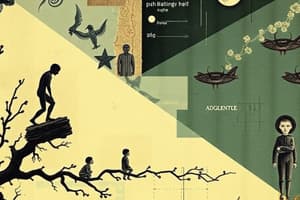Podcast
Questions and Answers
Which of the following macromolecules is NOT one of the four that make up living organisms?
Which of the following macromolecules is NOT one of the four that make up living organisms?
- Proteins
- Vitamins (correct)
- Nucleic Acids
- Carbohydrates
All animals reproduce through asexual reproduction.
All animals reproduce through asexual reproduction.
False (B)
What process involves breaking down molecules for energy?
What process involves breaking down molecules for energy?
Catabolism
Insects typically have ___ pairs of wings.
Insects typically have ___ pairs of wings.
Match the following components of an insect's body to their functions:
Match the following components of an insect's body to their functions:
What is the primary purpose of the DNA in organisms?
What is the primary purpose of the DNA in organisms?
Generalist animals can only survive in specific habitats.
Generalist animals can only survive in specific habitats.
How do organisms typically respond to environmental changes?
How do organisms typically respond to environmental changes?
Which type of mouthparts do insects NOT have?
Which type of mouthparts do insects NOT have?
Arachnids have three body segments.
Arachnids have three body segments.
What is the role of spiracles in insects?
What is the role of spiracles in insects?
Insects undergo __________ metamorphosis, where they develop through egg, larva, pupa, and adult stages.
Insects undergo __________ metamorphosis, where they develop through egg, larva, pupa, and adult stages.
Match the insect order with its corresponding example.
Match the insect order with its corresponding example.
Which statement about the competitive exclusion principle is correct?
Which statement about the competitive exclusion principle is correct?
Crustaceans have a closed circulatory system.
Crustaceans have a closed circulatory system.
Name one benefit of arachnids in human interaction.
Name one benefit of arachnids in human interaction.
The __________ rule states that only 10% of energy is transferred between trophic levels.
The __________ rule states that only 10% of energy is transferred between trophic levels.
What type of organism typically occupies the first trophic level?
What type of organism typically occupies the first trophic level?
Flashcards
What is the exoskeleton of an insect?
What is the exoskeleton of an insect?
Insects have a tough, outer covering that protects them.
What are the three body regions of an insect?
What are the three body regions of an insect?
Insects have three main body parts: a head, a thorax, and an abdomen.
How do insects breathe?
How do insects breathe?
They use spiracles and trachea.
What is the difference between complete metamorphosis and incomplete metamorphosis?
What is the difference between complete metamorphosis and incomplete metamorphosis?
Signup and view all the flashcards
What does the competitive exclusion principle explain?
What does the competitive exclusion principle explain?
Signup and view all the flashcards
What is predation?
What is predation?
Signup and view all the flashcards
What is symbiosis?
What is symbiosis?
Signup and view all the flashcards
What are the main characteristics of arachnids?
What are the main characteristics of arachnids?
Signup and view all the flashcards
What is the main body structure of a crustacean?
What is the main body structure of a crustacean?
Signup and view all the flashcards
What is ecdysis in crustaceans?
What is ecdysis in crustaceans?
Signup and view all the flashcards
What are the main characteristics of insects?
What are the main characteristics of insects?
Signup and view all the flashcards
What does the head of an insect contain?
What does the head of an insect contain?
Signup and view all the flashcards
What are the four main macromolecules that make up life?
What are the four main macromolecules that make up life?
Signup and view all the flashcards
What drives development in organisms?
What drives development in organisms?
Signup and view all the flashcards
How do animals exhibit behaviors?
How do animals exhibit behaviors?
Signup and view all the flashcards
How does animal anatomy support its survival?
How does animal anatomy support its survival?
Signup and view all the flashcards
How do herbivores and carnivores differ in their digestive systems?
How do herbivores and carnivores differ in their digestive systems?
Signup and view all the flashcards
What process drives growth in animals?
What process drives growth in animals?
Signup and view all the flashcards
Study Notes
Properties of Life
- Life is composed of four macromolecules: proteins, lipids, carbohydrates, and nucleic acids.
- Life exhibits hierarchical organization from cells to ecosystems, with emergent properties.
- Life reproduces through biogenesis (life from life).
- DNA carries genetic information essential for inheritance and function.
- Metabolism involves catabolism (breaking down molecules) and anabolism (building molecules).
- Development involves differentiation and growth, influenced by genetics and environment.
- Organisms interact with their environment through adaptations and responses.
- Movement enables organisms to interact with the environment, find resources, and avoid threats.
Animal Kingdom Overview
- Animals are multicellular, eukaryotic organisms with specialized structures for movement, nutrition, and reproduction.
- Animal behaviors are either instinctive or learned.
- Niche specialists have specific habitat and food needs, while generalists adapt to diverse environments.
- Animal anatomy supports survival, with adaptations for feeding, movement, and reproduction.
- Animals may have simple or complex digestive systems.
- Herbivores and carnivores differ in their digestive systems for processing different foods (plants, animals).
- Growth occurs through mitosis and cell division.
- Sexual reproduction involves gametes (egg and sperm). Mitosis creates somatic cells, meiosis creates gametes.
Insects
- Insects have three body segments (head, thorax, abdomen), three pairs of legs, and typically two pairs of wings.
- Head: Contains eyes (simple or compound), antennae (sensory), and mouthparts (chewing, sucking, siphoning).
- Thorax: Holds wings and legs.
- Abdomen: Houses digestive, reproductive, and excretory systems.
- Insects are classified into orders (Coleoptera, Diptera, Lepidoptera, Hymenoptera).
- Nutrition includes herbivory, carnivory, or omnivory.
- Insects have an open circulatory system.
- Gas exchange occurs through spiracles and trachea.
- Insects have specialized sense organs.
- Defense mechanisms include color patterns (aposematic, crypsis, mimicry), and physical defenses (stingers, venom).
- Metamorphosis occurs through incomplete (egg, nymph, adult) or complete (egg, larva, pupa, adult) stages.
Arachnids
- Arachnids belong to the phylum Arthropoda, subphylum Chelicerata, class Arachnida.
- Orders include Araneae (spiders), Scorpiones (scorpions), Opiliones (harvestmen), and Acari (mites and ticks).
- Arachnids have two body segments (cephalothorax and abdomen), eight legs, chelicerae (fangs), and pedipalps.
- Movement involves hydraulic pressure in legs.
- Prey capture varies (webs or active hunting).
- Defense mechanisms include venom, camouflage, or urticating hairs.
- Arachnids can be beneficial (pest control) or harmful (disease transmission).
- Ticks are parasitic, feeding on blood with a life cycle of larvae, nymphs, and adults.
Crustaceans
- Crustaceans belong to the phylum Arthropoda, subphylum Crustacea.
- Examples include Malacostraca (crabs, lobsters) and Maxillopoda (barnacles).
- Crustaceans have biramous appendages (two branches).
- They are mainly benthic (sea floor) or sessile (attached).
- Anatomy includes a fused head and thorax (cephalothorax).
- Appendages are specialized for feeding, movement, and reproduction.
- Crustaceans use gills for respiration, have a heart for circulation, and digestive systems for different food strategies.
- Growth involves ecdysis (molting).
- Transport of eggs is external.
- Crustaceans play roles in food webs (decomposers, zooplankton, and symbiosis).
Species Interactions and Ecology
- Competition: Occurs when species share limited resources, follows the competitive exclusion principle.
- Predation: One organism preys on another for food.
- Symbiosis: Includes mutualism (both benefit), commensalism (one benefits, other is unaffected), and parasitism (one benefits, the other is harmed).
- Trophic levels: Organisms are classified in trophic levels (producers, primary consumers, etc.).
- The 10% rule describes energy transfer between trophic levels.
- Carrying capacity: The maximum population size supportable by resources.
- Biotic potential: Maximum reproductive capacity under ideal conditions.
- Over-shoots and diebacks: Population exceeding capacity leading to decline.
Evolutionary Concepts
- Darwin's theories: Natural selection and descent with modification explain species evolution.
- Evidence for evolution: Includes fossil record, morphology, biogeography, and genetics.
- Classification systems: Hierarchical (Kingdom, Phylum, Class) from phenetic (similar traits) to phylogenetic (evolutionary relationships). Note that convergent evolution affects phenetic classification.
Studying That Suits You
Use AI to generate personalized quizzes and flashcards to suit your learning preferences.




